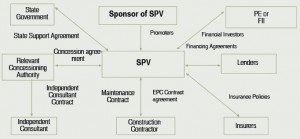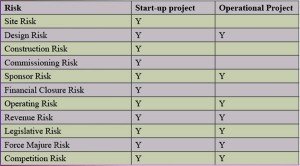Many factors come into play while assessing the risks at various stages of a Transport Project under PPP. The credit rating agencies assess these risks and provide an expert opinion on the overall risks in the project. A look at the various factors considered in the process.
 Given the robust pace of economic development, infrastructure bottleneck – especially in the transport sector – has been a serious concern in India. While the Government is expected to continue to be the major provider of roads, the massive shortfall in the supply of roads combined with scarcity of resources has forced the Government to consider augmenting its resources through Public Private Partnership (PPP) model in Road Projects (RPs).
Given the robust pace of economic development, infrastructure bottleneck – especially in the transport sector – has been a serious concern in India. While the Government is expected to continue to be the major provider of roads, the massive shortfall in the supply of roads combined with scarcity of resources has forced the Government to consider augmenting its resources through Public Private Partnership (PPP) model in Road Projects (RPs).
The implementation of a Road Project involves a number of stages – right from the pre-construction processes to the construction work, and later, the operation and maintenance of the road. As the risks at each of these stages differ, they must be properly identified and classified in a systematic manner to understand the impact on the credit profile of the RP. Credit Rating Agencies (CRAs), being regulated by the Securities Exchange Board of India (SEBI) and Reserve Bank of India (RBI), play an important role in assessing the various risks associated with the debt issue of RPs. They provide a credit opinion keeping in view the characteristics of the Indian road sector and the associated risks.
Each of the project specific factors pertaining to a RP is analysed in-depth by the agencies. At CARE Ratings (one of the rating agencies), the approach essentially comprises the assessment of the broad parameters of the project based on the detailed project report and the systematic analysis of various contractual obligations of the related parties. Thus, an independent professional risk opinion pertaining to RP shall be a vital input for investment decision to various classes of investors like the banks, financial institutions and other strategic participants and shall assist in portfolio monitoring on an ongoing basis. For the RPs, credit rating assists in determining the borrowing terms and conditions, facilitates access to new sources of funds/markets and provides a framework for disclosure and transparency for, as we believe, “an opinion can show you the way”.
The enabling environment for successful execution and operation of a large number of PPP projects includes unambiguous and tested legal and regulatory framework, standardised contract documents with the freedom to make project specific amendments, scheme to support the economically essential but financially unviable infrastructure projects, fund to support the project development activities, the capacity building and skill enhancement measures for developers, operators and financing agencies and the ability to revamp the financial system to ensure the flow of adequate funds.
 The constraints faced by projects in general and road projects, in particular, include the delay in land acquisition, co-ordination between the Government agencies and the huge gap in funding requirements.
The constraints faced by projects in general and road projects, in particular, include the delay in land acquisition, co-ordination between the Government agencies and the huge gap in funding requirements.
It is for these reasons that steps have been taken for augmentation of resources. These include the setting up of IIFCL & IFCs, higher exposure limits of banks for infrastructure funding, hiking of limits for investment by FIIs and dedicated infrastructure funds for equity funds.
A typical road project is domiciled in a Special Purpose Vehicle (SPV). The SPV has a fixed duration, well defined scope, purpose and provides broad revenue visibility. The roles and responsibilities of the parties involved are generally clearly defined. The utilisation of revenue inflows is clearly documented in a tight water fall mechanism. The CRAs analyse the cash inflows and utilisation in-depth for determining the rating. As the road projects take a long period to recover the investments, they are vulnerable to event risks.
The Basics
Under the PPP model, the road developer forms a Special Purpose Vehicle (SPV) to execute the construction work assigned by the Concessioning Authority (CA). These projects generally use the project financing technique on a Build Operate Transfer (BOT) basis. Annuity and toll are two forms of BOT projects based on which the Developer executes the road projects. In the annuity model, the road developer is compensated for the cost of building the road in fixed semi-annual installments by the CA, usually after the projects start commercial operations. Under BOT-Toll, the revenue generation would mainly be from the toll collected from road users based on the “pay as you use principle”.
The road projects have to obtain a number of clearances/approvals and their timely receipt is critical for execution of projects in time and commencing tolling or receipt of annuities. The revenue risks in an annuity project are lower as compared to a toll project as successful execution of a road project requires effective involvement of a large number of parties with well defined roles and responsibilities. Their abilities and track record are important in risk assessment. Then of course, the geography and terrain in which the road is located are also important.
The SPV route for implementing a PPP project confers two distinct advantages. The rating is based on the independent strength of the projects and there is no co-mingling risk for the cash generated with any other business of the project sponsor. However, structure has its negatives too – the resource support from the promoter is restricted only up to the equity contribution and there could be problems in funding cost overruns.
Major factors in risk assessment
Promoter Related Risk
- Experience in PPP
- Financial Strength / flexibility
Project Execution Risk
- EPC terms
- Site /RoW Risk
- Pending Approvals
- Project Funding, e.g. leverage, status of financial closure, etc.
Revenue Risk
- Credit Quality of the annuity provider
- Traffic Risk (alternate road, subcontract, toll auctions) Toll rate acceptance & revision risk
- Other sources if any- real estate development rights, advertising rights, etc.
O & M risk
- Quality of O&M Contractor
- Routine and Periodic Maintenance
- Any MMRA created or not
- Topography or nature of stretch
Cash flow risk- DSRA creation, etc.
Local Political risk
Government policies
Other Case specific
- Constitution of Entity
- Foreign currency risk
- Interest rate risk
- Credit enhancements
In case of discounting of toll receipts – Quantum of Debt raised Vs Actual toll generating capacity
The overall risk assessment from the credit perspective would be thus:
Profile of Concessioning Authority — NHAI (Low risk), State Roads (Moderate risk) and Other roads (relatively higher risk)
- Strong Sponsor – Low risk
- Fixed EPC, O&M contract – Favourable for SPV, crystallises cash outgo
- Toll-Moderate risk; Annuity – Low Risk
- RoW risk – Highest risk in project execution stage
- Reserve creations – MMRA and DSRA creations- Favourable for SPV
- Higher contribution of MAVs in traffic mix-Favourable
Suggestions for successful PPP route for development include uniform definition for infrastructure, evolving operational framework for processing unsolicited bids, evolving a consensus on utilisation of land for industrial and infrastructure projects, improved co-ordination between different departments/agencies of the Government, suitable credit enhancement for project loans, working out of a public sector comparator, grading of projects, project participants, classification of PPP projects as a separate lending category and revamping of data collection.
P N Sathees Kumar
Chief General Manager
CARE Ratings
(P N Sathees Kumar is Chief General Manager, CARE in charge of rating/grading of a few large corporate houses and entities belonging to different sectors including IT & ITS, telecom, steel, power components, hospitality, shipping, ports and logistics. He has twenty eight years of experience in financial services. Areas of expertise include institutional appraisal, resource mobilisation and project/credit appraisal. He has worked with apex financial institutions like IDBI and SIDBI.)
 TrafficInfraTech Magazine Linking People Places & Progress
TrafficInfraTech Magazine Linking People Places & Progress

